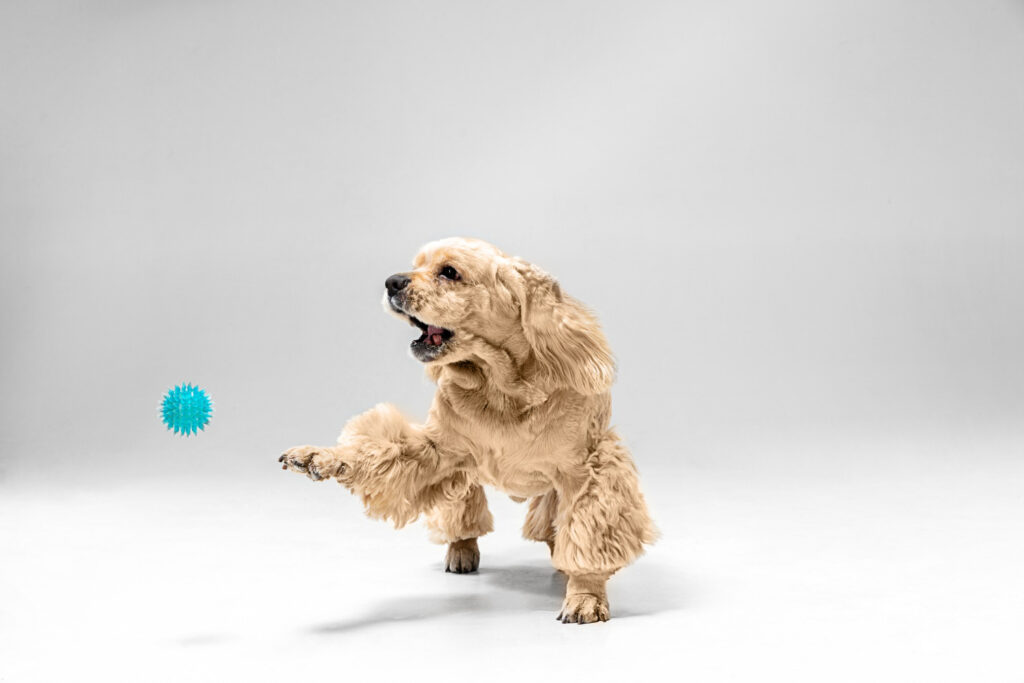If you’ve ever watched your furry friend excitedly engage with a squeaky toy, only to be met with tears and whimpers, you may wonder why my dog cries when he plays with squeaky toys. It’s a perplexing behavior that can leave pet owners puzzled and concerned.
This blog post will delve into the fascinating world of dogs and their relationship with these seemingly innocuous playthings. We’ll explore possible reasons behind their emotional response, discuss the role of training and socialization, and provide helpful tips on managing or preventing crying during playtime.
Possible reasons for crying while playing with squeaky toys
There could be several reasons why your dog cries while playing with squeaky toys. One possibility is that the high-pitched noise of the toy triggers their instinctual prey drive, causing them to become overexcited or anxious. This excitement may manifest as crying or whining.
Another reason could be that your dog expresses frustration or pent-up energy during playtime. They might cry if they cannot fully satisfy their need for physical activity and mental stimulation. In this case, providing more exercise and engaging activities outside of playtime could help alleviate their crying behavior.
Additionally, some dogs may cry when playing with squeaky toys because they have learned that it elicits attention from their owners. If every time they make a noise, you rush over to check on them or give them treats; they may continue the behavior as a means of getting your attention.
It’s also worth considering whether underlying health issues could affect your dog’s crying behavior. Pain or discomfort can cause dogs to vocalize during playtime. Consulting with a veterinarian is essential if you suspect this may happen. Every dog is unique and may have different reasons for crying while playing with squeaky toys. Understanding their individual needs and preferences will help you identify potential triggers and find ways to address the issue effectively without dampening their joy in playtime.
The emotional connection between dogs and their toys

- Dogs and their toys share a unique emotional bond beyond mere play. For our furry friends, toys are more than objects to chase and chew on – they become cherished companions that provide comfort and entertainment.
- The high-pitched sound triggers an instinctual response when a dog plays with squeaky toys. Dogs have an innate drive to seek out and capture small prey animals, such as rodents or birds. The squeaking noise mimics the sounds of wounded prey, activating their predatory instincts.
- But it’s not all about hunting for dogs; their toys also serve as sources of comfort and security. Many dogs form strong attachments to particular toys by associating them with positive experiences or memories. These beloved possessions often provide solace when dogs are feeling anxious or lonely.
- Additionally, playing with squeaky toys can mentally stimulate our canine companions. It allows them to engage in problem-solving activities while enjoying physical exercise. This mental stimulation is essential for keeping dogs entertained and preventing boredom-related behavior problems.
- The emotional connection between dogs and their toys is further enhanced through interactive play sessions with humans. We strengthen our bond by providing attention, affection, and shared enjoyment by actively participating in playtime with our pets using these squeaky treasures.
- Understanding this emotional connection can help explain why some dogs may cry while playing with squeaky toys – it could be a display of excitement or frustration at being unable to catch the “prey.” Please watch your dog’s body language during playtime to ensure they enjoy themselves without becoming overwhelmed or distressed.
The role of training and socialization in a dog’s response to squeaky toys
Training and socialization are crucial in shaping a dog’s response to squeaky toys. Dogs are intelligent creatures capable of learning and adapting their behavior based on their experiences. We can teach our furry friends how to appropriately engage with these toys without crying through proper training.
During the early stages of training, you must introduce your dog to different types of toys, including squeaky ones. Gradually expose them to the sound and encourage positive associations by rewarding calm behavior. This will help desensitize them and reduce their fear or anxiety towards loud noises.
Socialization also plays a significant role in shaping a dog’s response to squeaky toys. Exposing your dog to environments, people, and other animals early can help build their confidence and teach them appropriate ways to interact with stimuli.
Consistency is vital when it comes to training dogs. Set clear boundaries and reinforce good behavior while redirecting unwanted behaviors such as excessive crying during playtime with squeaky toys. Patience and positive reinforcement techniques will go a long way in helping your furry friends understand what is expected of them.
Remember that every dog is unique, so adapt your training methods accordingly. Some dogs may require more time or specialized approaches depending on their temperament or past experiences. Always consult a professional trainer if you face challenges addressing your dog’s crying behavior during playtime with squeaky toys.
Tips for managing or preventing crying during playtime with squeaky toys:

1. Choose a suitable toy: Some dogs may be more sensitive to specific sounds or textures. Experiment with different types of squeaky toys to find one your dog enjoys without causing distress.
2. Gradual desensitization: If your dog seems anxious when playing with a squeaky toy, try introducing it slowly and gradually. Start by offering the toy at a distance and rewarding calm behavior, then gradually bring it closer.
3. Positive reinforcement: Use treats and praise to reward your dog for calm behavior during playtime with squeaky toys. This can help create positive associations and reduce any anxiety or stress they may have.
4. Provide alternative outlets: If your dog becomes overly fixated on their squeaky toy, consider providing other forms of mental stimulation, such as puzzle toys or interactive games, to distract them from excessive crying.
5. Seek professional help if needed: If you’ve tried various strategies and your dog continues to cry excessively while playing with squeaky toys, it may be beneficial to consult a professional trainer or veterinarian who can assess any underlying issues contributing to this behavior.
Understanding and addressing underlying issues that may contribute to the behavior
Understanding and addressing underlying issues contributing to a dog’s crying during playtime with squeaky toys ensures their well-being and enjoyment. While some dogs call out of excitement or frustration, others may be experiencing discomfort or anxiety.
One possible reason for a dog’s tears could be fear or sensitivity to the high-pitched sound of the squeaker. Certain dogs may find this noise overwhelming and respond by crying or exhibiting signs of stress. In such cases, it is essential to gradually desensitize them to the sound through positive reinforcement training techniques.
Additionally, some dogs might have had negative experiences associated with loud noises, making them more prone to crying when playing with squeaky toys. Patience and understanding are essential when helping these dogs overcome their fears.
Another factor contributing to a dog’s emotional response could be separation anxiety. Dogs who suffer from separation anxiety often become distressed when left alone, which can manifest during playtime as well. It is essential to address this issue through proper training and gradual exposure so that they feel secure even during solo play sessions.
In certain instances, excessive crying while playing with squeaky toys may indicate an underlying health problem or pain. If your dog consistently calls during playtime despite efforts to address behavioral issues, it would be wise to consult a veterinarian who can rule out any medical conditions causing discomfort.
Understanding why your dog cries while playing with squeaky toys allows you to provide appropriate support and create an enjoyable experience for you and your furry friend. Addressing any underlying issues contributing to their behavior sensitively and patiently can help alleviate their distress and enhance their overall happiness during playtime.
Conclusion: Enjoying playtime with your dog without tears
Now that we’ve explored why dogs may cry when playing with squeaky toys, it’s important to remember that every dog is unique. While some dogs may express excitement or frustration during play, others might have deeper emotional issues that need addressing.
To ensure a positive and tear-free playtime experience for both you and your furry friend, here are a few tips:
1. Observe and understand: Listen to your dog’s behavior while playing with squeaky toys. Are they showing signs of distress or discomfort? Understanding their body language can help you identify any underlying issues.
2. Gradual desensitization: If your dog consistently cries during playtime, consider slowly introducing them to the sound of squeaky toys in a controlled environment. Start by exposing them to low-volume squeaks and gradually increase the volume over time as they become more comfortable.
3. Provide alternatives: If your dog seems particularly sensitive to the noise of squeaky toys, try offering alternative types of toys that don’t produce loud sounds but still provide mental stimulation and physical exercise.
4. Training and socialization: Proper training and socialization from an early age can help teach dogs appropriate behaviors during playtime. Enroll in obedience classes or seek guidance from professional trainers who can assist in preparing your dog how to control their emotions while engaging with toys.
5. Seek professional help if needed: If, despite trying these tips, your dog continues to exhibit excessive crying or displays other concerning behaviors during playtime, it may be beneficial to consult with a veterinarian or animal behaviorist for further evaluation and guidance.


